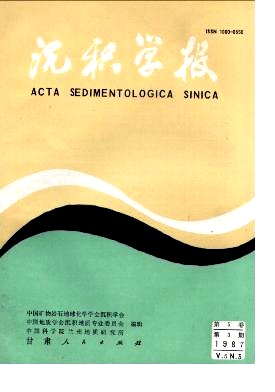STUDING AND MAPPING LITHOFACIES PALEOGEOGRAPHY OF QINGLONG GROUP OF LOWER-MIDDLETRIASSICINTHE LOWER YANGTZE VALLEY
- Publish Date: 1987-09-10
Abstract: The working area deals with five provinces, i. e. Jiangsu, Zhejiang. Anhui, Jiangxi and Hubei. It is mainly in the lower Yangtze Valley and also includes a part of the middle Yangtze Valley. Qinglong Group of lower-middle Triassic is widely distributed in the area and especially well outcropped along the Yangtze River. The greatest thickness of Qinglong Group is more than 1260 meters and there exist various sedimentary rocks and a well potential of oil and gas. Qinglong Group can be divided into four formations. They are Yinkeng Formation, Helongshan Formation, Biandanshan Formation and Dongmaanshan Formation ascendently. The first three formation belong to lower Triassic and the last one to Middle Triassic. There are three kinds of different rocks in the Qinglong group, i. e. carbonte rocks, clastic rocks and evaporites. Carbonte rocks including limestone and dolostone are most widely distributed in the area. The limestone can be divided into the following types: shallow-water grainstone, stromatolitic limestone, gravity flow limestone, tempestits, ( in situ ) microcrystalline limestone, nodule limestone and ''worm'' limestone. The dolostone can be classified into penecontemporaneous and postpenecontemporaneous dolostone. This paper using "the single factor analysis and comprehenisve mapping method" which was initiated by the author. "The single factor" is that it can independently reflect some respects of sedimentary environments such as lithological, paleontologi-cal of other characteristics. This method includes three steps. Firstly, a thorough lithological study for every section sepecially basic section should be made in order to obtain various firsthand, complete, reliable qualitative and quantitative data, especially the latter. Secondly, the single factors should be selected from the quantitative data, then the content (%) of various single factors of each mapping unit can be obtained, and the fundamental single factor maps ( mainly isoline maps ) of each mapping unit can be drawn. These fundamental single factor maps can quantitatively reflect characteristics of sedimentary environments from different respects. This is "the single factor analysis". Thirdly, on the basis of these fundamental single factor maps of every mapping unit, combined with other quantitative and qualitative information and other regional geological information, discarding the dross and selecting theessential, through comprehensive analysis and judgement, the lithofacies paleogeographic map of the mapping unit in the area can be worked out. This is "comprehensive mapping". In this paper, the following single factors were selected: thickness, shallow-water grains content, penecontemporaneous dolostone content, gravity flow sediment content, the sedimentary thickness ratio of deep-water to shallow-water, terrigenous materials content, thickness of dark colour bed and of gypsum rock bed. In Yinkeng Formation, the five maps of fundamental single factor were drawn. They are the isopach map, the isoline map of the sedimentary thickness ratio of deep water to shallow water, the isoline map of gravity flow sedimentary content (%), the isoline map of shallow-water grain content (%) and the isoline map of terrigenous material content (%). With the comprehension of these fundamental single factor maps combined with other environmental indicators, through analysis and comprehensive judgement, the lithofacies paleogeographic map in Yinkeng Age of Early Triassic in the lower Yangtze Valley was worked out. With the same method, we had drawn the lithofacies paleogeographic maps of Helongshan Age, Biaadanshan Age and Dongmaanshan Age. In Yinkeng Age, the lower Yangtze Sea had such a Paleogeographic feature characterized by "four division" as shallow-water clastic rock platform, shallow-water carbonate rock platform, deep-water slope and deep-water basin from south to north. The shallow-water clastic rock platform was mainly composed of mudstone, shale and siltstone which was the marginal facies zone of "Cathay Old Land" in the south of the
| Citation: | Feng Zengzhao, Wu Shenghe. STUDING AND MAPPING LITHOFACIES PALEOGEOGRAPHY OF QINGLONG GROUP OF LOWER-MIDDLETRIASSICINTHE LOWER YANGTZE VALLEY[J]. Acta Sedimentologica Sinica, 1987, 5(3): 40-58. |






 DownLoad:
DownLoad: